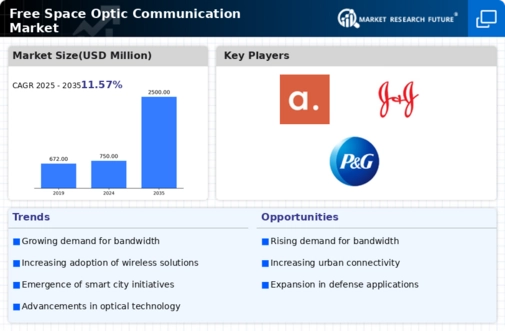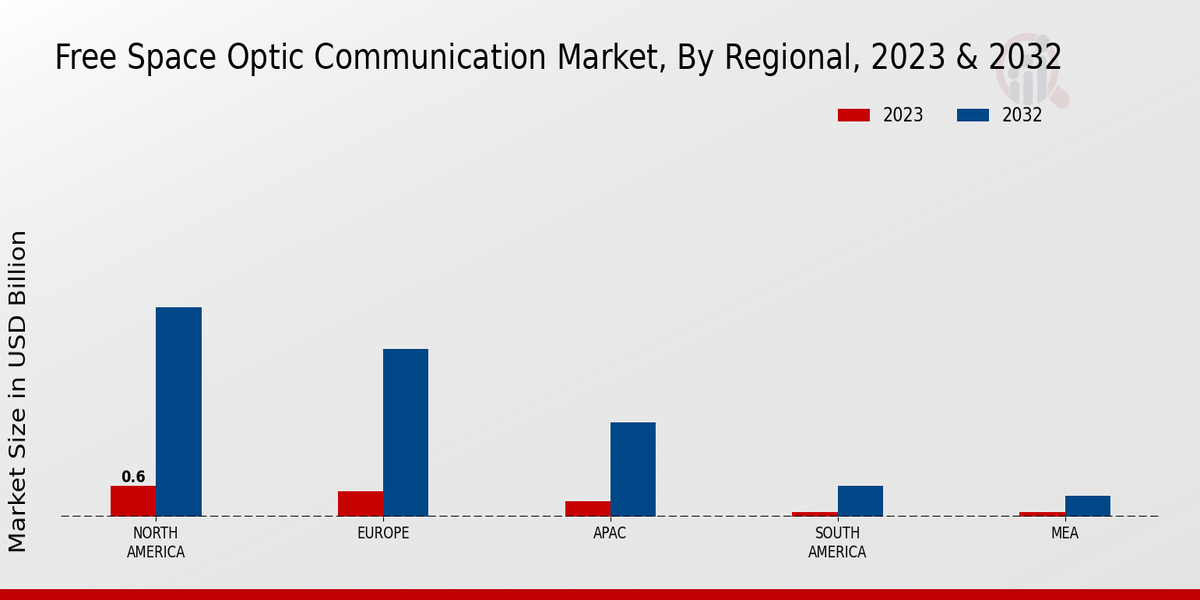Market Growth Projections
The Global Free Space Optic Communication Market Industry is poised for substantial growth, with projections indicating a market size of 750 USD Million in 2024 and an anticipated increase to 2500 USD Million by 2035. This growth trajectory reflects a compound annual growth rate of 11.57% from 2025 to 2035, driven by various factors including the demand for high-speed data transmission, expansion of telecommunications infrastructure, and advancements in optical communication technology. As these trends continue to unfold, the market is likely to attract significant investment and innovation, positioning free space optics as a key player in the future of communication.
Expansion of Telecommunications Infrastructure
The expansion of telecommunications infrastructure globally is a significant driver for the Global Free Space Optic Communication Market Industry. As countries invest in modernizing their communication networks, free space optics presents an attractive solution for connecting remote areas and enhancing urban connectivity. Governments are increasingly recognizing the potential of this technology to bridge the digital divide, particularly in regions lacking reliable internet access. This investment trend is expected to contribute to the market's growth, with projections indicating a rise to 2500 USD Million by 2035, highlighting the long-term potential of free space optics in telecommunications.
Rising Need for Secure Communication Solutions
Security concerns in data transmission are driving the Global Free Space Optic Communication Market Industry. With the increasing frequency of cyber threats, organizations are seeking secure communication methods that can safeguard sensitive information. Free space optics offers inherent security advantages, as it utilizes light beams that are difficult to intercept without detection. This characteristic makes it particularly appealing for sectors such as finance and government, where data security is paramount. As awareness of these security benefits grows, the market is likely to see increased adoption, further propelling its growth in the coming years.
Growing Demand for High-Speed Data Transmission
The Global Free Space Optic Communication Market Industry is experiencing a surge in demand for high-speed data transmission solutions. As organizations increasingly rely on data-intensive applications, the need for faster communication methods becomes paramount. Free space optics offers a viable alternative to traditional fiber optics, providing high bandwidth capabilities without the need for physical cabling. This trend is particularly evident in urban areas where infrastructure development is constrained. The market is projected to reach 750 USD Million in 2024, indicating a robust growth trajectory as businesses seek to enhance their communication networks.
Technological Advancements in Optical Communication
Technological advancements in optical communication are significantly influencing the Global Free Space Optic Communication Market Industry. Innovations in laser technology, modulation techniques, and receiver sensitivity are enhancing the performance and reliability of free space optics systems. These advancements enable higher data rates and longer transmission distances, making the technology more competitive against traditional communication methods. As research and development efforts continue to evolve, the market is expected to benefit from improved product offerings, attracting more users and potentially increasing market share in the broader telecommunications landscape.
Increased Adoption of Wireless Communication Technologies
The Global Free Space Optic Communication Market Industry is benefiting from the increased adoption of wireless communication technologies. As businesses and consumers alike demand more flexible and scalable communication solutions, free space optics emerges as a compelling option. This technology allows for rapid deployment and can be integrated into existing wireless networks, enhancing overall performance. The anticipated compound annual growth rate of 11.57% from 2025 to 2035 underscores the growing acceptance of free space optics as a mainstream communication method, driven by the need for efficient and high-capacity data transmission.













